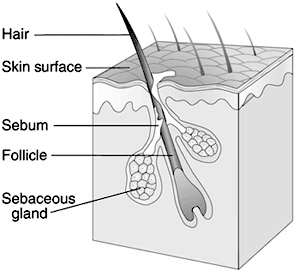We are all familiar with the fact that our bodies do not belong to us alone. We provide homes for up to 1000 bacterial species that live in our skin, our saliva, and our intestines, just to mention a few of several locations. It shouldn’t be a surprise that there is also a wide variety of multicellular microorganisms such as yeasts and mites taking refuge within us, but how many of them are we aware of? Are there more species than we realize that are living right under our noses?

Cross section view of hair follicle and sebaceous (oil) gland where face mites prefer to live. Source: Wikipedia – Sebaceous gland
It turns out that biologist Megan Thoemmes and her research team has recently found that face mites are indeed present under each and every adult nose, a recent CBC news article confidently – but questionably – reports. The two species found on human faces, Demodex brevis and Demodex folliculorum, are less than half a millimeter long, semitransparent, and either live within human pores or on hair follicles. The article reports that these creatures were found in all 253 tested adults of Thoemmes’s study, and so it is (rather pretentiously) suggested that the mites are universally existent on adult humans over age eighteen.
But isn’t the reporter jumping to conclusions?
Upon reading the original research paper, the answer is immediately clear. In actuality, there were 253 skin-scraping samples gathered, but only from nineteen participants, in contrast to the reported 253 adult participants. Extrapolating from 253 localized adults to the entire adult human population would be a hasty overgeneralization, let alone drawing conclusions from the actual sample size of nineteen. Moreover, an aspect that was completely disregarded in the article was that the participants sampled were chosen for their high apparent levels of skin-oil production, so perhaps the high frequency of face mites may not apply to everyone.

Scanning Electron Microscope image of the underside of a face mite. Source: Wikimedia Commons – Category: Demodex
In an effort to draw interest to the news article (based on the interview available in the voice clip below), the reporter used conclusive language throughout to heavily imply that all adults are hosts to face mites. By selectively filtering out some information and accompanying inferences with subtle uncertainty, along with the misreport of sample size, the article appears to be believably conclusive when in reality it is distorted and misleading, even if unintentionally so.
An example like this serves as a much needed wake-up call. Whether you’re a scientist or simply someone desiring to gain some insight into recent scientific developments and discoveries, it is absolutely essential that nothing is accepted without question. It is easy to draw conclusions from headlines as they are presented, but if proper discretion is not taken, you may be misled more than you are informed. As for whether or not we all have mites on our faces, only time and careful research will tell.
An audio clip of the interview with Megan Thoemmes is available below. Notice that a hasty generalization is made right at the start within the first minute of the track:
Audio clip: Adobe Flash Player (version 9 or above) is required to play this audio clip. Download the latest version here. You also need to have JavaScript enabled in your browser.
Dustin Woo
